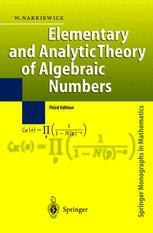

Most ebook files are in PDF format, so you can easily read them using various software such as Foxit Reader or directly on the Google Chrome browser.
Some ebook files are released by publishers in other formats such as .awz, .mobi, .epub, .fb2, etc. You may need to install specific software to read these formats on mobile/PC, such as Calibre.
Please read the tutorial at this link: https://ebookbell.com/faq
We offer FREE conversion to the popular formats you request; however, this may take some time. Therefore, right after payment, please email us, and we will try to provide the service as quickly as possible.
For some exceptional file formats or broken links (if any), please refrain from opening any disputes. Instead, email us first, and we will try to assist within a maximum of 6 hours.
EbookBell Team

5.0
68 reviewsThe aim of this book is to present an exposition of the theory of alge braic numbers, excluding class-field theory and its consequences. There are many ways to develop this subject; the latest trend is to neglect the classical Dedekind theory of ideals in favour of local methods. However, for numerical computations, necessary for applications of algebraic numbers to other areas of number theory, the old approach seems more suitable, although its exposition is obviously longer. On the other hand the local approach is more powerful for analytical purposes, as demonstrated in Tate's thesis. Thus the author has tried to reconcile the two approaches, presenting a self-contained exposition of the classical standpoint in the first four chapters, and then turning to local methods. In the first chapter we present the necessary tools from the theory of Dedekind domains and valuation theory, including the structure of finitely generated modules over Dedekind domains. In Chapters 2, 3 and 4 the classical theory of algebraic numbers is developed. Chapter 5 contains the fundamental notions of the theory of p-adic fields, and Chapter 6 brings their applications to the study of algebraic number fields. We include here Shafarevich's proof of the Kronecker-Weber theorem, and also the main properties of adeles and ideles.